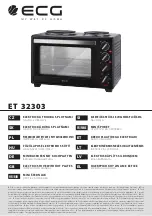
43
EN
Maintenance and cleaning
Cleaning exchanger - stove off
Fouling act as insulation and the thicker they are,
the lower the heat that is transmitted to the water
and to the structure generally. Therefore very
important to perform the cleaning of the tube
bundle, said exchanger also, to prevent the fouling
of the same and prevent clogging and jamming of
the cleaning device. Pull and push quickly for 5-6
times the lever so that the springs can remove the
soot deposited on the pipes.
Cleaning of painted pats
Do not clean the painted parts with wet rags when
the unit is in operation or hot to prevent thermal
shock to the paint which may cause it to detach.
Do not use abrasive or aggressive products or
materials. Clean with damp cotton or paper towels.
The silicon paints used by manufacturer possess
technical characteristics that make them resistent
to very high temperatures. There is however a
physical limit (380° C - 400° C) beyond which the
paint begins to fade or (over 450°) to vitrify; it may
then fl ake and detach from the steel surface. If this
happens, it means that temperatures have been
reached that are far above those at which the unit
should operate properly.
Check every 2/3 days
Cleaning the ash collection compartment
Clean and empty the ash tray being careful with
hot ash. The ash must be completely cold for a
vacuum cleaner to be used to remove it. Only if the
ash is completely cold, you can also use a canister
vacuum cleaner suitable for picking up particles of
a certain size.
Avoid contact with skin cleanser
and eyes. In case this happens,
sprinkle with plenty of water
and contact the nearest medial
center.
Do not use abrasive materials or
harsh. Clean with damp cotton or
paper towels.
Flame-shell cleaning
Cleaning of stainless steel and satin-fi nish
surfaces
Normally these surfaces do not need to be treated,
but if they do, avoid cleaning them with abrasive
materials. For surfaces in stainless and satin
brushed steel we recommend cleaning with a
paper towel or a clean dry cloth moistened with a
detergent based on non-ionic surfactants (<5%) A
spray glass cleaner may be used.
Cleaning ash and combustion chamber
including the spark plug lead.
Summary of Contents for IDRO 20
Page 56: ...56 IT NOTE Cod 001117...
Page 112: ...56 EN NOTES Cod 001117...
Page 168: ...56 FR NOTES Cod 001117...
Page 224: ...56 ES NOTAS Cod 001117...
Page 280: ...56 PT Cod 001117 NOTAS...
Page 336: ...56 DE Cod 001117 HINWEISE...
Page 392: ...56 DE NL 56 Cod 001117 OPMERKINGEN...
Page 393: ...GR GR1 CANADIAN IDRO 20 Cod 001117...
Page 395: ...GR 3 6 mm A1 UNI EN ISO 17225 2 3 42 kg...
Page 403: ...GR 11 UNI 10412 2 2009 C 60 C A1 3 4 M A2 3 4 M B1 1 2 B2 1 2 M A1 A2 B2 B1...
Page 404: ...GR 12 30 UNI CTI 8065 4...
Page 405: ...GR 13 1 bar 1 5 bar 1 14 1 bar 0 3 bar...
Page 406: ...GR 14 3 1 2 6 5 3 volt 4 3 3 4...
Page 407: ...GR 15 15 15 C 0 12 12 20 20 30 30 6 mm 30 mm 8 A1 UNI EN ISO 17225 2...
Page 429: ...GR 37 1 BLACK OUT 2 3 4 5 I 6 I 7 90 C 8 I TRIAC COC C D E 1300...
Page 430: ...GR 38 On Off On Off 1 BLACK OUT 1 10...
Page 431: ...GR 39 100 C ALAR DEP FAIL ALAR DEP FAIL 100 C ALAR SIC FAIL ALAR SIC FAIL 4A 2 5 bar 5 C 10...
Page 432: ...GR 40 2 3 15 30 60 90...
Page 433: ...GR 41 5 6 380 C 400 C 450 C 2 3 INOX 5...
Page 434: ...GR 42 60 90 20 24 28 32...
Page 435: ...GR 43 2 3 15 30 60 90 5 6...
Page 436: ...GR 44 2 3 INOX 5 380 400 450...
Page 437: ...GR 45 7 60 90 20 24 28 32...
Page 438: ...GR 46 2 3 3 15 AT T 16 16...
Page 439: ...GR 47 T...
Page 440: ...GR 48 OFF 1300 SERV SERV...
Page 441: ...GR 49 1 2 1 2 1 2 1 2 3 1 2 3 4 5 1 2 3 4 5 1 2 3 4 5 6 1 2 I 3 4 5 6...
Page 443: ...GR 51 1 2 1 2 1 2 3 1 2 3 1 1 1 1 1 2 3 1 2 3 1 2 1 65 C 40 C 80 C 50 55 C 50 55 C 2 1 2 1 2...
Page 444: ...GR 52 1 1 1 2 1 2 1 2 1 230 C 2 1 1 4 6 1 2 3 4 5 1 2 3 4 5...
Page 445: ...53 24 1 2 3 GR...
Page 446: ...GR 54 001117...
















































